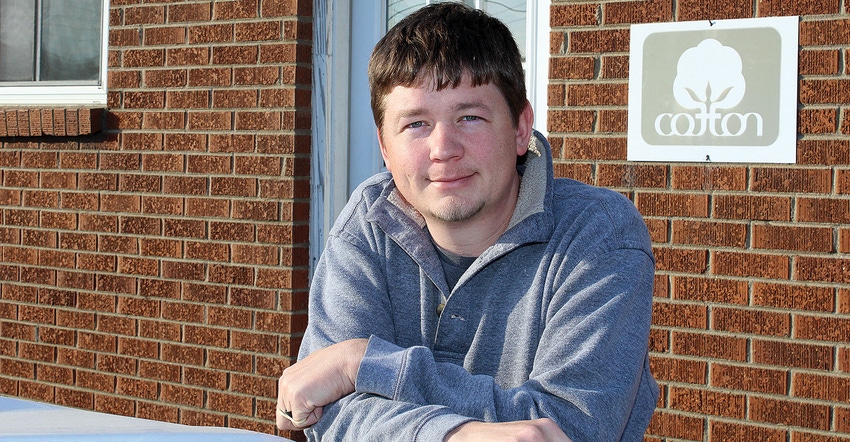
The first time Lee Inboden walked into a gin, he was immediately enamored with the sights, sounds and smells of everything about it. He noticed how the people worked collectively to make the operation run smoothly, and when his mother called asking what he thought, he told her he wanted to work there.
He interviewed with MaLeisa Finch, gin manager, Kiech-Shauver-Miller Gin in Monette, Ark., twice before he asked for the job and she said yes. Inboden’s first responsibility was just to learn — to learn as much as he could about the gin, the warehouse, the eCotton software, and how cotton flowed from the field through the gin and warehouse, and finally on to the next stop in cotton’s supply chain.
“I started in August of 2012,” remembers Inboden. “MaLeisa encouraged me to learn the marketing side of the business initially, and in the fall of that year, she put me in charge of our safety program.”
Working with SCGA
Longtime safety director Larry Davis was Inboden’s first connection to the Southern Cotton Ginners Association. Davis introduced Inboden to the safety business and showed him the positive impact a good safety program and resulting positive safety record could have for a gin.
“It’s not just about giving a periodic safety briefing. It’s about conditioning your gin crew to perform their duties in a specific way to guard them against impulse reactions,” adds Inboden. “It’s also about teaching them to maintain attention from distractions that can possibly lead to trouble.”
When Inboden began reviewing the SCGA safety program outlined for all Mid-South gins, he began to understand that a thorough safety program included in-depth documentation, inspections, and carefully written safety plans he could tailor to Kiech-Shauver-Miller gin. “Today we have a complete ‘lock-out/tag-out’ program, a hazardous communications program, and detailed emergency action plans,” adds Inboden.
The high-profile annual safety awards program coordinated through William Lindamood, current SCGA safety director, is an important incentive to gins across the Mid-South. The program has been in place for decades. Walk into any gin across the Mid-South and you will see plaques prominently displayed on gin office walls.
“The SCGA program was here long before I became involved with ginning safety, but it’s a great way to award those gins whose safety records deserve to be recognized,” adds Inboden. “We strive to make our work environment safe for every one of our employees.”
William Lindamood took over as SCGA safety director after Davis retired. Lindamood’s background is fashioned for the job and he is passionate about what he does. Growing up around Phoenix Gin in Tiptonville, Tenn., Lindamood returned home in the early 1990s to assist in an upgrade of the capacity and performance of the gin after leaving an engineering sales job in Seattle, Wash., where he sold aircraft parts to Boeing.
“We could not have found a more qualified person to take the place of Larry Davis,” says Tim Price, who was selected by the SCGA Board to assume leadership of the association in 2003 after the retirement of Lee Todd. “William’s family background and previous career positions were scripted to fill this position.”
For anyone not familiar with gins across the five states comprising the Mid-South, they range from the most modern with high-capacities, to gins that are 45-plus years old with more limited performance. “Many of today’s modern gins incorporate process control technologies that improve efficiencies and overall performance,” explains Lindamood. “Some also have electronic ‘fail-safe’ safety features like electronic locks that prevent lint cleaner doors from opening while saws are moving, or pressure matts that, when stepped on, immediately shut off machines in operation.”
These technologies augment manual emergency stops and crew training in situational awareness throughout the gin.
No matter the size of a gin or its capacity, Lindamood audits them all annually to make sure their safety programs reflect standards mandated by the Occupational Health and Safety Administration (OSHA). “Our gin, which was built in 2010, has some of these fail-safe features and they play a critical role protecting our workers,” says Inboden.
An excellent safety program leading to a good safety record can decrease a gin’s workman’s comp premiums — an important economic advantage for any gin.
Inboden unfortunately understands the magnitude of accidents. No matter how often you are around equipment, dangers still exist. Lee knows that from personal experience after losing his grandfather this past August in a tractor accident — a tractor that he had been on countless times. “Farming and ginning are inherently dangerous professions, and we all must remain diligent each day to keep everyone safe,” adds Inboden. “Everyone works in close proximity here at the gin. We really are like family.”
About the Author(s)
You May Also Like




